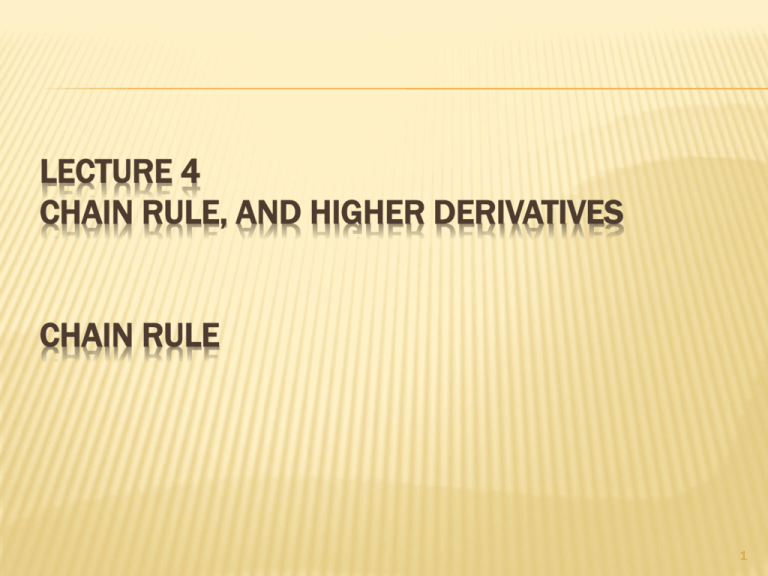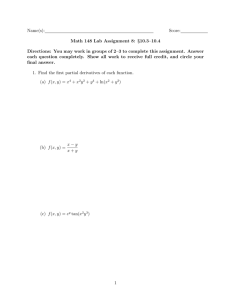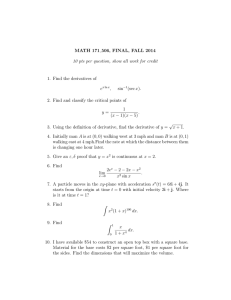Higher Derivatives
advertisement

LECTURE 4 CHAIN RULE, AND HIGHER DERIVATIVES CHAIN RULE 1 MIT OpenCourseWare http://ocw.mit.edu 18.01 Single Variable Calculus Fall 2006 For information about citing these materials or our Terms of Use, visit: http://ocw.mit.edu/terms. 2 We’ve got general procedures for differentiating expressions with addition, subtraction, and multiplication. What about composition? Example 1. y = f(x) = sin x, x = g(t) = t 𝑑𝑦 So, y = f(g(t)) = sin(t2). To find, , write: 𝑑𝑡 𝑡 = 𝑡0 𝑡 = 𝑡0 + ∆𝑡 𝑥 = 𝑥0 𝑥 = 𝑥0 + ∆𝑥 𝑦 = 𝑓(𝑥0 ) 𝑦 = 𝑦0 + ∆𝑦 3 Δ𝑦 Δ𝑦 Δ𝑥 = . Δ𝑡 Δ𝑥 Δ𝑡 As Δt → 0, Δx → 0 too, because of continuity. So we get: 𝑑𝑦 𝑑𝑡 = 𝑑𝑦 𝑑𝑥 𝑑𝑥 . 𝑑𝑡 ← The Chain Rule! 4 In the 𝑑𝑥 𝑑𝑡 𝑑𝑦 example, = 2𝑡, and = 𝑑𝑥 𝑑 𝑑𝑦 𝑑𝑥 2 So, (sin(𝑡 )) = . 𝑑𝑡 𝑑𝑥 𝑑𝑡 cos 𝑥. = (cos 𝑥)(2𝑡) = (2𝑡) cos(𝑥 2 ) 5 ANOTHER NOTATION FOR THE CHAIN RULE 𝑑 𝑓 𝑑𝑡 𝑔 𝑡 ′ = 𝑓 𝑔 𝑡 𝑔′(𝑡) (or 𝑑𝑦 𝑓 𝑑𝑥 𝑔 𝑥 = 𝑓 ′ 𝑔 𝑥 𝑔′ 𝑥 ) 6 EXAMPLE 1. (CONTINUED) Composition of functions 𝑓(𝑥) = sin 𝑥 and 𝑔 𝑥 = 𝑥2 𝑓 ° 𝑔 𝑥 = 𝑓 𝑔 𝑥 = sin 𝑥 2 𝑔 ° 𝑓 𝑥 = 𝑔 𝑓 𝑥 = sin2 (𝑥) Note: 𝑓 ° 𝑔 ≠ 𝑔 ° 𝑓. Not Commutative! 7 COMPOSITION OF FUNCTIONS: 𝑓 ° G(X) = F(G(X)) 8 EXAMPLE 2. Let u = 𝑑 1 COS 𝑑𝑥 𝑥 =? 1 𝑥 𝑑𝑦 𝑑𝑦 𝑑𝑢 = 𝑑𝑥 𝑑𝑢 𝑑𝑥 𝑑𝑦 𝑑𝑢 1 = −𝑠𝑖𝑛 𝑢 ; = − 2 𝑑𝑢 𝑑𝑥 𝑥 1 𝑠𝑖𝑛 𝑑𝑦 𝑠𝑖𝑛 (𝑢) −1 𝑥 = = (−𝑠𝑖𝑛 𝑢) = 2 2 𝑑𝑥 𝑥 𝑥 𝑥2 9 EXAMPLE 3. 𝑑 . 𝑑𝑥 𝑥 −𝑛 = ? There are two ways to proceed. 𝑥 −𝑛 = 𝑥 −𝑛 = 1 𝑥𝑛 𝑑 𝑑𝑥 𝑥 −𝑛 = −𝑛𝑥 − 𝑛−1 𝑥 𝑑 𝑑𝑥 −𝑛 𝑥 −𝑛𝑥 − = 𝑛−1 𝑑 1 𝑛 𝑑𝑥 𝑥 −2 1 𝑛−1 −1 =𝑛 𝑥 𝑥2 −𝑛−1 1 𝑛 , 𝑥 or = = −𝑛𝑥 𝑑 1 𝑑𝑥 𝑥 𝑛 𝑛−1 = 𝑛𝑥 (Think of 𝑥 𝑛 as u) −1 𝑥 2𝑛 = 10 HIGHER DERIVATIVES Higher derivatives are derivatives of derivatives. For instance, if 𝑔 = 𝑓′, then ℎ = 𝑔′ is the second derivative of f. We write ℎ = 𝑓 ′ ′ = 𝑓′′. 11 Notations Higher derivatives are pretty straightforward —just keep taking the derivative! 𝑓′ 𝑥 𝐷𝑓 𝑑𝑓 𝑑𝑥 𝑓′′(𝑥) 𝐷2 𝑓 𝑑2 𝑓 𝑑𝑥 2 𝑓′′′(𝑥) 𝐷3 𝑓 𝑑3 𝑓 𝑑𝑥 3 𝑓 𝑛 (𝑥) 𝐷𝑛 𝑓 𝑑𝑛 𝑓 𝑑𝑥 𝑛 12 EXAMPLE. 𝐷 𝑛 𝑥 𝑛 = ? Start small and look for a pattern. 𝐷𝑥 = 1 𝐷 2 𝑥 2 = 𝐷 2𝑥 = 2 ( = 1 ∙ 2) 𝐷 3 𝑥 3 = 𝐷 2 3𝑥 2 = 𝐷 6𝑥 = 6 ( = 1 ∙ 2 ∙ 3) 𝐷 4 𝑥 4 = 𝐷 3 4𝑥 3 = 𝐷 2 12𝑥 2 = 𝐷 24𝑥 = 24 ( = 1 ∙ 2 ∙ 3 ∙ 4) 13 The notation n! is called “n factorial” and defined by n! = n(n − 1) · · · 2 · 1 Proof by Induction: We’ve already checked the base case (n = 1). Induction step: Suppose we know 𝐷𝑛 𝑥 𝑛 = 𝑛! case. Show it holds for the (𝑛 + 1)𝑠𝑡 case. 𝐷𝑛+1 𝑥 𝑛+1 = 𝐷𝑛 (𝐷𝑥 𝑛+1 ) = 𝐷𝑛 (𝑛 + 14 Thank You! 15











